Amicus Anthology Films: Tales of Terror
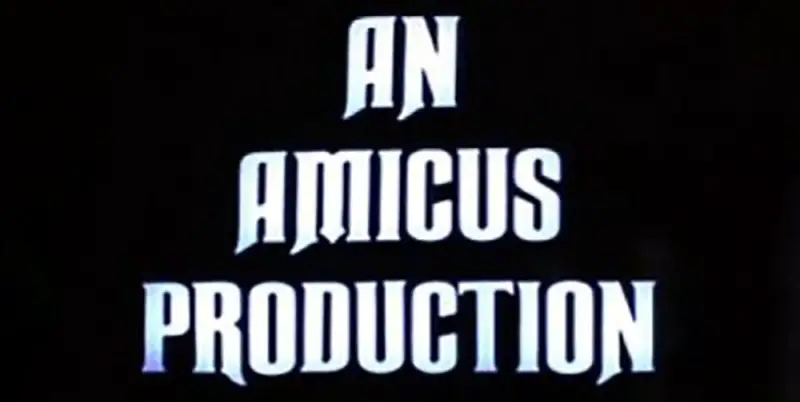
Massive film lover. Whether it's classic, contemporary, foreign, domestic, art,…
Amicus Studios had the reputation for being the rival studio to England’s famed horror factory Hammer studios throughout the 1960’s and 70’s. While that may be true in some respects, Amicus also had the goods to make some truly enjoyable horror anthologies that managed to be both entertaining and scary.
As a devout fan of Hammer studios, it feels nearly traitorous to be praising their rival Amicus, but to ignore their body of work would just be flat out ignorant, as Amicus proved to be a formidable rivalry to the house of horrors that Hammer was known for.
In an ironic turn of events that are most likely the grounds for this rivalry, Amicus founder Max Rosenberg and Milton Subotsky had submitted a script for a Frankenstein remake to Hammer prior to establishing Amicus. Hammer’s principal writer and producer Anthony Hinds saw too many similarities to Universal’s Frankenstein series, and passed on the script due to the various concerns of copyright infringement.
Starting with the structural formula that would make their portmanteau films standout in their horror cannon, Dr. Terror’s House of Horrors was the first of Amicus’ anthology films.
Dr. Terror’s House of Horrors (1965)
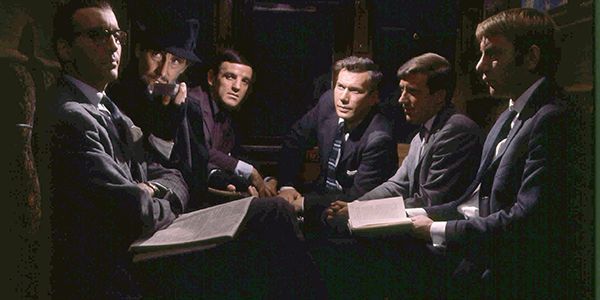
Many great actors would fill the screen in this series of films, but Dr. Terror’s House of Horrors might have the best role call: Peter Cushing and Christopher Lee (after striking gold starring across from each other in Hammer’s most successful horror films Horror of Dracula, Curse of Frankenstein, The Mummy), Michael Gough, Max Adrian, Alan Freeman, and a young American actor named Donald Sutherland.
Despite the title, there is no “house of horrors.” Remember, though, it’s an anthology film, so we are not bound to any setting. Peter Cushing plays the titular character (don’t worry, nobody calls him “Dr. Terror”). Playing against the gaunt, dapper characters we usually associate him with, here he’s a scruffy gypsy-like soothsayer whose tarot deck foretells the deadly premonitions of the five characters who find themselves trapped in a train car together. Each of these titles has a similar narrative tie in, but Cushing’s presence assuredly elevates this title.
The five ensuing tales range from classic supernatural storylines with werewolves and vampires; to sci-fi with killer plants (Day of the Triffids perhaps?), an intentionally comedic one (which would become a tradition in these films) featuring real life jazz musician Roy Castle dabbling with voodoo; and the strongest segment, starring Christopher Lee as a snotty art critic whose lambasting of Michael Gough leads to a dubious murder/revenge from beyond the grave story. Famed DP (previous to his career as director he was the cinematographer for The Innocents), Freddie Francis directs this horror film with confidence and humor. Ironically, the Amicus films that are the strongest usually feature crews and actors from Hammer; in this case Cushing, Lee, and the film’s director who would volley from Hammer to Amicus in the following years.
The films finale would repeat itself for all of the following portmanteau Amicus films, and at the risk of both being redundant and spoiling not one, but five movies, I’ll just say that the destinies for five people who see visions of their ghastly demise don’t ride off into the sunset.
Torture Garden (1967)
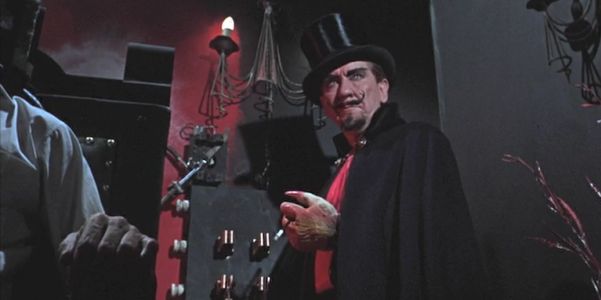
Torture Garden was originally intended to star Cushing and Lee; however, since the film was backed by Columbia, they insisted that they cast Burgess Meredith and Jack Palance instead. Despite the lack of Christopher Lee, Peter Cushing remains and of course delivers yet another memorable performance in the film’s final sequence.
In Cushing’s place as the emcee of ghastly prophecies is Burgess Meredith, turning in an entertaining performance as carnie turned fortune teller, known as “Dr. Diablo”. Dr. Diablo then introduces us to four tales of terror, including a possessed piano, patricide, android celebrities, and two Edgar Allen Poe fans (Cushing and Palance), whose bickering leads to the summoning of none other than Poe himself!
A pattern established early on in these films is to have a sense of humor, and Torture Garden does just that and more. While the sound of evil pianos and android movie stars may sound silly, the film has a respectable script written by Robert Bloch. While time may have taken the edge off of some of these titles, the important thing to remember is that these films don’t take themselves seriously, which is why they remain so memorable and fun.
Watching Burgess Meredith (many might know him better as Rocky’s grizzled trainer) ham it up and break the fourth wall is an added bonus.
The House that Dripped Blood (1971)
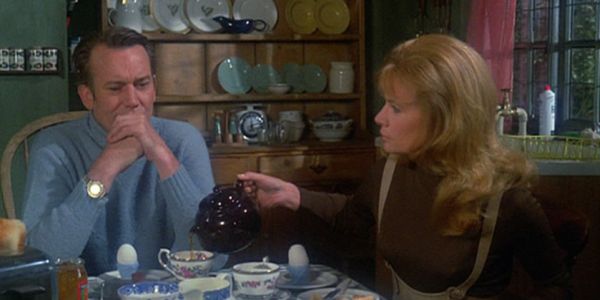
While genre veteran Freddie Francis moved away from these anthologies, Peter Duffel is up to the task in one of the standout titles in the series: The House that Dripped Blood. All of these titles are “standout” for one reason or another, and despite having a “cool” title this third outing seems like Amicus hit their stride with their portmanteau formula.
The film is armed with a strong cast of character actors and Hammer regulars, including Denholm Elliot, Ingrid Pitt, Jon Pertwee, Peter Cushing and Christopher Lee. Robert Bloch returns for his second Amicus anthology with all original stories in this screenplay.
The first, A Method for Murder, is an entertaining opening featuring Denholm Eliot as a horror writer who is having a hard time with his own fictional creation (and marriage). The result, as you might guess, doesn’t work out for him too well. Waxworks follows, with Cushing becoming fixated on a cryptic model resembling a woman he once knew. Sweets to the Sweet is a creepy object lesson with Christopher Lee, whose overbearing parenting “skills” land him in a rather compromising fate at the hands of his own daughter. The final chapter, The Cloak, is a rather entertaining in-movie joke about a pompous actor who feels like he’s above the B-movie horror films (get it?) he’s starring in, especially the vampire-themed Curse of the Bloodsuckers, in which he dons a cloak that was the property of a real vampire.
While The House that Dripped Blood might not be the most original horror film, it is well intended and entertaining. It won’t blow your mind or put you in shock, but you will enjoy the accessibility of the material.
Tales From the Crypt (1972)

No, not the HBO show, but Tales from the Crypt does have a crypt keeper (Ralph Richardson), and draws inspiration from the EC Comics of the same name. If The House that Dripped Blood was the film that defined the Amicus formula, Tales from the Crypt perfected it.
The film has some truly brilliant moments in its five tales. It starts with a bang in the first story, as Joan Collins spreads some holiday cheer by murdering her husband, only to be stalked by a homicidal lunatic dressed as jolly St. Nick in the first story And All Through the House.
Poetic Justice is another memorable entry. Arthur Grimsdkye (Peter Cushing) is a kindly old man, whose genuine affection for the children of the neighborhood becomes the subject of a smear campaign by his villainous neighbors, who consider him an eyesore. Their beratement leads to Grimsdyke’s suicide; however, the kind old man isn’t so kind from beyond the grave.
The finale, Blind Alleys, is a knockout and might be one of the best in the anthology series. Nigel Patrick takes over a care center for the blind, and in the bad guy tradition makes drastic budget cuts. As a result, a patient dies. Revenge is of course exacted, and the negligent director experiences the dangers of life without sight.
The tie around this time is a lot less involved than Dr. Terror’s House of Horrors and The House That Dripped Blood, which leaves more room for story development. The now commonly overused and parodied theme of the ironically punished evildoer is hit on the head in these films, and most efficiently utilized in the mid-section of these Amicus titles.
Asylum (1972)
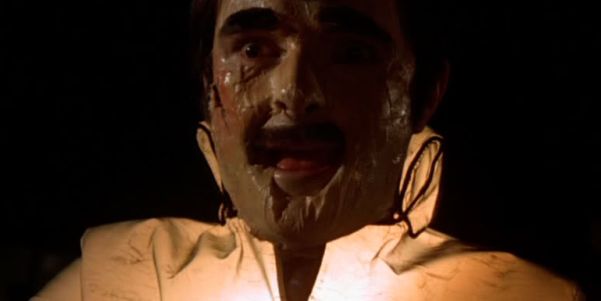
Asylum might be the most unique in the Amicus canon, which is a bold statement considering it’s contending with possessed pianos and killer plants.
Recurring character actor Patrick Magee plays the administrating doctor Rutherford, who presides over the titular institution that houses the “incurably insane”. In order to determine if his interviewee Dr. Martin (Robert Powell) qualifies for the position, Martin must deduce who was the former chief MD of the asylum by surveying a variety of the patients – what better way to host a variety of macabre stories?
We have a routine, but superlative marital murder sequence, but the following story The Weird Tailor is a contender for the best story of the film. Peter Cushing approaches as a not-so-weird tailor, who’s met by a weird request to make a suit from a mysterious fabric that reanimates whatever (or whoever) it is worn by. Hallucinatory, strange, and scary, The Weird Tailor is yet another creepy tale of the supernatural.
Lucy Comes to Stay is an effective, if simple tale of psychological terror, and the following Mannikins of Horror is anything but routine of simple. His last patient to interview is revealed to be the Dr. Byron (Herbert Lom), whose mannequins he hopes to bring to life, namely the one that has the face of Dr. Rutherford. He also insists that the insides are organic, and they operate with a miniature system of organs like that of a human being. But hey, he’s the one in the asylum, so who knows?
The miniature mannequins are better characterized as tiny robots, and this segment is great because it leads into the film’s epilogue, tying the resolution into another chapter of terror. And the deadly automated windup robots advance on Dr. Rutherford, killing him with a scalpel. Just when you thought things couldn’t get any weirder, we also see that Byron was right, these little Frankenstein-like wind up toys do have human-like innards.
Vault of Horror (1973)

Vault of Horror is frequently paired alongside Tales from the Crypt as a double feature (perhaps that’s because of 20th Century Fox’s Midnite DVD series, and also Scream Factories Blu-ray double feature). But not for nothing, the two films do compliment each other nicely. The other tie in is the comic connection. While the film Vault of Horror might share the same name of the EC comics, the film continues to draw from the Tales from the Crypt comics, except for one segment The Neat Job, which was inspired by an EC Shock SuspenStories series.
Vault of Horror’s tales might not be as original as the Amicus films written by Robert Bloch, but the film is loaded with clever scares and laughs along the way. If you edited the tie-ins from Tales from the Crypt to Vault of Horror, the two films would seamlessly work as one.
The framing story is less significant. At this point, audiences know what they’re walking into, and Vault of Horror limits the tie in to a group of people taking a lift to a room, where they sit down and share their stories. Quick, witty, and entertaining, the proceedings of Vault of Horror follow a “safe” but effective mission statement.
Midnight Mess is the first, a quickie about vampires. The Neat Job is another funny case of matricide, whose principle theme is parodied by Mr. Stotch in a South Park episode. This Trick’ll Kill You is about a couple whose meddling with magic in India doesn’t end well, while Bargain in Death is another tale of deceit where a man buries himself alive as an insurance scam. The finale hearkens back to the early days of Dr. Terror’s House of Horrors. It is about a painter named Moore, who lives in Haiti and finds that his work is being valued by the same people who criticized his work for being worthless. Moore turns to voodoo to exact his revenge. Returning to England, his portraits of those who wronged him become the painter’s equivalent of voodoo dolls. However, he should have remembered this with his own self portrait – remember the “ironic punishment” theme brought up earlier?
Vault of Horror, much like Tales from the Crypt, is formulaic and well intended; it might not deliver genuine scares but it is fun to watch.
From Beyond the Grave (1974)
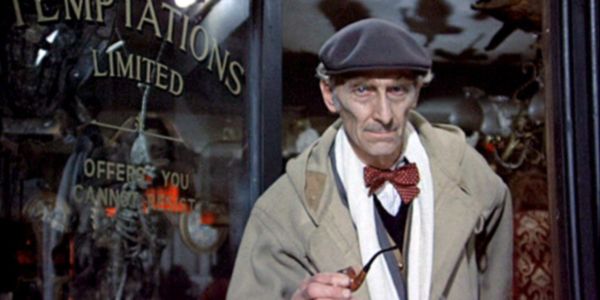
The final “official” anthology from Amicus, From Beyond the Grave is my personal favorite. The cast is (this may sound redundant) stellar. Peter Cushing plays the tie-in emcee, a cryptic proprietor of an antique shop called “Temptations Limited”, who will jinx anyone that schemes or crosses him. The following stories star genre stalwarts David Warner, Donald Pleasance, Angela Pleasance, John O’Farrell, Ian Carmichael, Margaret Leighton, and Ian Ogilvy.
The first story, the effectively chilling The Gatecrasher, stars David Warner as a man who lowballs Cushing on an antique mirror. After bragging that he swindled the antique, he’s haunted by a ghastly apparition that compels him to kill! Of course, it has something to do with the mirror.
The second, which is usually a lighter and more funny entry, is this time meaty and memorable, if also consistent with the preceding films. A pushover office manager who is bullied by his wife lies about being a decorated soldier, and befriends a street vendor who was actually a former soldier. The reveal is too much fun to spoil here, so just see the film. Donald and Angela (real life daughter) Pleasance are worth the price of admission alone.
The Elemental, the shorter, more comedic entry, is a fun romp with yet another twist ending. The final and perhaps the best segment, which is a bold claim to make given the rest of the film being so strong, is The Door. Fascinated by his purchase, Ogilvy becomes enamored with his new door. When the door reveals a strange blue room behind it, it also hosts more than he had bargained for.
The final tie in is great. Instead of five shorter tales, From Beyond the Grave hosts four sturdy and thoroughly realized tales of terror that have all the characteristics that make these Amicus films such a pleasure.
Tales that Witness Madness (1973) – Honorable Mention

While it may not be an official Amicus film, Tales that Witness Madness is still worthy of an honorable mention. If not the best portmanteau film, it’s still fun, with some worthwhile segments. Remember, if you don’t like a storyline, you don’t have to wait long.
Donald Pleasance, Joan Collins, Jack Hawkins, and Kim Novak are great as always, but the film lacks the veneer that the other Amicus anthologies boasted so well. The first segment Mr. Tiger and Mel are memorable, if strange. The first is about a boy who manifests a tiger to deal with his bickering parents, and the second about a man who becomes obsessed with an oddly suggestively shaped tree.
Epilogue
What makes these films so memorable? It’s not that they’re particularly scary, and they might not even be that original. But these movies are genuinely fun in that spirit of surprise and nostalgia, capturing the comic book-like aesthetic that they derive some of their stories from. If you found the Creepshow duology too cartoonish, than these films are for you; if you did like them, the Amicus films are still worth your time.
Though these movies are distinctly British, these films were the brain child of American producer Milton Subotsky, who was of course influenced by the British classic Dead of Night. And if you’re referring to talkies, Dead of Night would be the first horror anthology (if you don’t count the 1924 German film Waxworks).
Although Amicus was seen as a “rival” to Hammer, they were more of a subsidiary from a fan’s point of view. And it seemed like they were at their strongest when working with Hammer’s top billing actors. Aside from The House that Dripped Blood, Freddie Francis and Roy Ward Baker helmed all of these films as directors; and if you ask me they did a great job. It’s no surprise, seeing as they both directed some great films for Hammer before and after these titles, including Dracula Has Risen from the Grave, Nightmare, The Evil of Frankenstein, The Anniversary, Dr. Jekyll and Sister Hyde, and Quatermass and the Pit.
Anthology films have been around since the silent days, and continue today with hits like the V/H/S series, and most recently Tales of Halloween. They’re a great sub-genre to horror films and serve as a great platform for creativity in the genre.
What is your favorite of the Amicus anthology films?
(top image source: Amicus Films)
Does content like this matter to you?
Become a Member and support film journalism. Unlock access to all of Film Inquiry`s great articles. Join a community of like-minded readers who are passionate about cinema - get access to our private members Network, give back to independent filmmakers, and more.
Massive film lover. Whether it's classic, contemporary, foreign, domestic, art, or entertainment; movies of every kind have something to say. And there is something to say about every movie.













